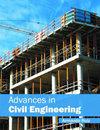Compression Mechanical Properties and Constitutive Model for Soft–Hard Interlayered Rock Mass
IF 1.6
4区 工程技术
Q3 CONSTRUCTION & BUILDING TECHNOLOGY
引用次数: 0
Abstract
The properties of soft–hard interbedded rock masses are significantly impacted by the strength of rock layers and the characteristics of interface surfaces. This study investigates the mechanical properties of soft–hard interlayered rock masses by preparing rock-like specimens with different interface angles. Uniaxial and triaxial compression tests were conducted to examine the compression mechanical characteristics of the specimens. Experimental results demonstrated that in the uniaxial compression tests, the peak strength of the two-layer rock-like specimen exhibits an initial decrease followed by an increase as the interface angle increases. Similarly, the peak strength of the three-layer rock-like specimen also follows a “U-shaped” pattern. The failure of both specimens shifts from tensile failure to shear failure. In the triaxial tests, the strength of the two-layer rock-like specimen initially increases and subsequently decreases as the interface angle increases. In contrast, the intensity of the three-layer rock-like specimen exhibits a decreasing trend, transitioning from shear dilation or tensile failure to shear failure. By utilizing the damage constitutive model to compute the compressive strength of the composite specimen, it was observed that the deviation from the experimental value did not exceed 2.5%, and the overall shape of the curves was in good agreement. Consequently, it is affirmed that the damage constitutive model developed in this study can accurately capture the pre-peak phase of the stress–strain relationship in soft–hard interlayered rock-like specimens, thus providing a valid representation of their mechanical behavior.软硬夹层岩体的压缩力学性能和构造模型
软硬夹层岩体的特性受到岩层强度和界面表面特征的显著影响。本研究通过制备不同界面角度的类岩试样,研究软硬夹层岩体的力学特性。通过单轴和三轴压缩试验来检验试样的压缩力学特性。实验结果表明,在单轴压缩试验中,随着界面角的增大,两层类岩石试样的峰值强度先降低后升高。同样,三层类岩石试样的峰值强度也呈 "U "型。两种试样的破坏都从拉伸破坏转变为剪切破坏。在三轴试验中,两层类岩石试样的强度最初随着界面角的增大而增大,随后随着界面角的增大而减小。相比之下,三层类岩石试样的强度呈下降趋势,从剪切扩张或拉伸破坏过渡到剪切破坏。通过利用损伤构成模型计算复合试样的抗压强度,发现与实验值的偏差不超过 2.5%,曲线的整体形状也非常吻合。因此,本研究建立的损伤构成模型可以准确捕捉软硬夹层岩类试样应力-应变关系的前峰值阶段,从而有效地反映其力学行为。
本文章由计算机程序翻译,如有差异,请以英文原文为准。
求助全文
约1分钟内获得全文
求助全文
来源期刊

Advances in Civil Engineering
Engineering-Civil and Structural Engineering
CiteScore
4.00
自引率
5.60%
发文量
612
审稿时长
15 weeks
期刊介绍:
Advances in Civil Engineering publishes papers in all areas of civil engineering. The journal welcomes submissions across a range of disciplines, and publishes both theoretical and practical studies. Contributions from academia and from industry are equally encouraged.
Subject areas include (but are by no means limited to):
-Structural mechanics and engineering-
Structural design and construction management-
Structural analysis and computational mechanics-
Construction technology and implementation-
Construction materials design and engineering-
Highway and transport engineering-
Bridge and tunnel engineering-
Municipal and urban engineering-
Coastal, harbour and offshore engineering--
Geotechnical and earthquake engineering
Engineering for water, waste, energy, and environmental applications-
Hydraulic engineering and fluid mechanics-
Surveying, monitoring, and control systems in construction-
Health and safety in a civil engineering setting.
Advances in Civil Engineering also publishes focused review articles that examine the state of the art, identify emerging trends, and suggest future directions for developing fields.
 求助内容:
求助内容: 应助结果提醒方式:
应助结果提醒方式:


